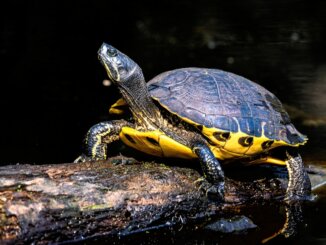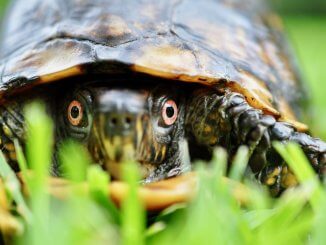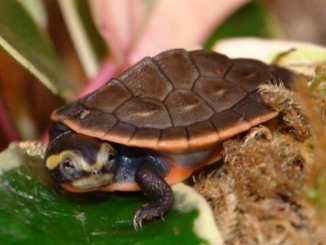The marginated tortoise is a large terrestrial tortoise with an oval-shaped, domed shell and a high, serrated dorsal scute. An adult has a black carapace with yellow highlights and a light-colored ventral shell. The shells are thick and hard around the center but are thinner and softer towards the outer edges.
This tortoise breed is endemic to Italy, Greece, and the Balkan islands. The tortoises have a high tolerance for heat and cold weather and can live in various habitats, including arid scrubland, woodlands, and even rocky mountain slopes.
The marginated tortoise is popular with reptile keepers because it is easy to care for and is a great tortoise breed for beginners. These animals’ hardy nature and minimal care requirements make caring for marginated tortoises an easy task
[article_toc]
Marginated Tortoise Overview
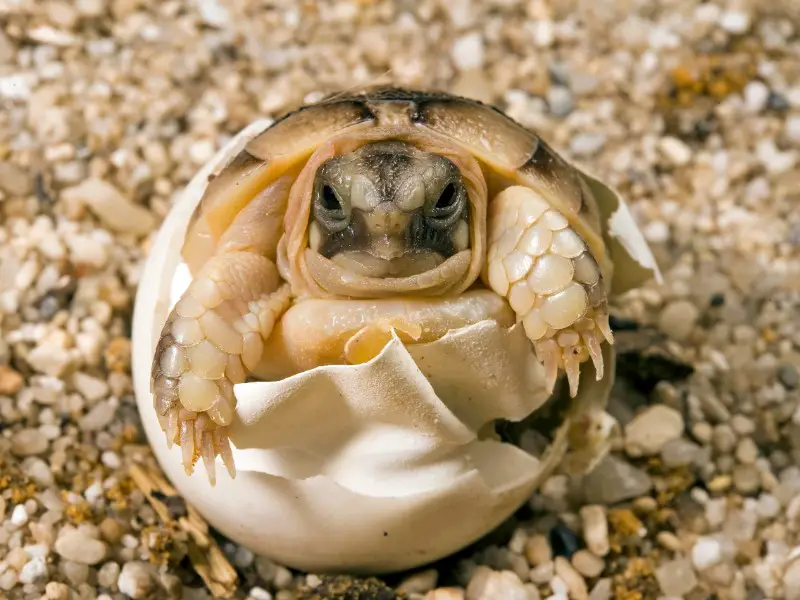
| Common name | Marginated tortoise |
| Scientific name | Testudo marginata |
| Natural habitat | Mediterranean region in Italy, Greece, and the Balkans Islands |
| Adult size | Up to 15.7 inches, up to 11 pounds |
| Average lifespan | 100–150 years |
| Diet | Herbivore |
| Housing | Outdoor secured fence. Day time temperature 72–80°F and humidity 60%–70% |
| Experience | Beginner |
Origin
The marginated tortoise (Testudo marginata) appears in southern parts of Greece, from the Peloponnese peninsula to Mount Olympus. Smaller groups are also present in the Balkans, Italy, and the European part of Turkey.
The natural habitat of the marginated tortoise is rough, xeric (dry), hilly terrain with scattered bushes and rocks. The tortoise also inhabits cold mountainous regions with an altitude of up to 5,200 feet. This tortoise isn’t an endangered species, but it’s hard to find in the wild.
Appearance and Behavior
Adult marginated tortoises have a hard oval- or round-shaped carapace (upper shell). The carapace is dark brown or black, with yellow highlights towards the middle of each plate.
The scutes feature a serrated (saw-toothed) edge that flares outward. Large scales cover the front parts of the limbs, and the head is relatively small with a long neck.
Male marginated tortoises have longer tails that thicken towards the base. Males are larger and have indented undersides on their carapace, while females are smaller and have a straighter, more level bottom. The flaring rear marginals of male carapaces further distinguish the males from females.
Size and Lifespan
Marginated tortoises average 10–15.7 inches in length and weigh up to 11 pounds. The shell length is 8.7 inches, and the height can reach 4.7 inches. Growth is fast within the first 20 years, at 3.5–17.6 ounces yearly, but starts to taper off during the turtle’s 20s.
The average lifespan of a marginated tortoise is 100–150 years. Marginated tortoises living in captivity have an average lifespan of 20–100 years. Providing the tortoises with a good diet, good housing, and good care will increase their lifespan.
Temperament
Marginated tortoises are friendly and have an active and curious nature. Wild marginated tortoises are calm but may become territorial when competing for mates. Lack of proper diet and nutrition can also make the tortoises aggressive.
The tolerant nature of marginated tortoises means they can stay with other tortoises of the same size without any problems. Occasional clashes occur when the tortoises try to establish dominance, but the fights are never deadly.
Handling marginated tortoises should be kept to a minimum. Too much handling can be stressful for the tortoise and cause health problems. Always support the tortoise’s body when picking it up, and never pick it up by the tail. Marginated tortoises don’t bite but can snap at your finger if they feel threatened.
Housing Marginated Tortoises
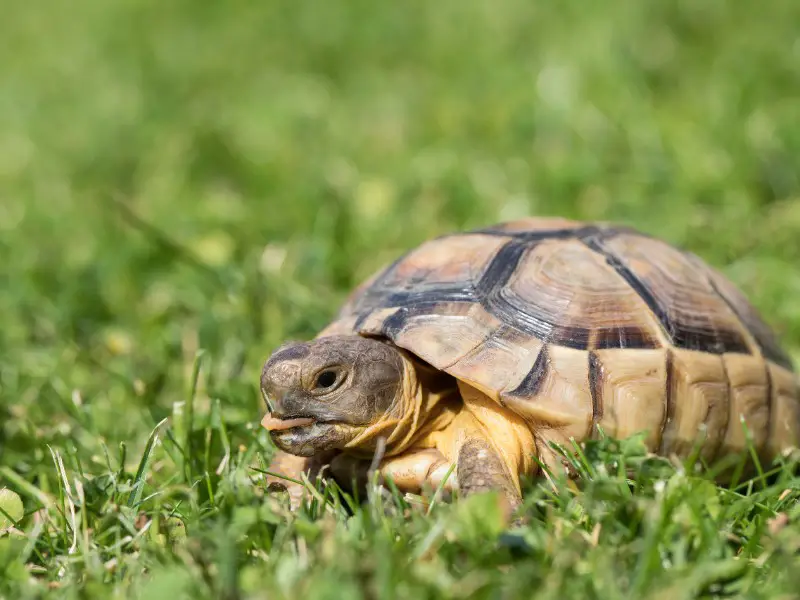
Mimicking the natural habitat of marginated tortoises reduces stress and promotes good health. Large enclosures with plenty of space to roam, hide, and bask are ideal. Use a mix of live and artificial plants and rocks and logs to create a naturalistic environment.
A wooden vivarium, glass terrarium, or plastic storage tub makes suitable indoor housing for a single marginated tortoise. Use a secure fenced-in area outdoors for larger groups of tortoises. The outdoor enclosure should have shady areas to protect the tortoises from the hot sun, and a place to hibernate in the winter.
Adding a basking spot is essential to maintain the proper temperature gradient in the enclosure. Basking lamps emit heat and light, providing warmth for the tortoises. The basking spot should be around 95°F, and the rest of the enclosure should range from 72 to 80°F.
Enclosure Size
Large, adult marginated tortoises need at least 100 square feet of space. Keeping tortoises together in a group also means the enclosure needs to be larger. Enclosures measuring 15 by 25 feet can accommodate a group of 12 adult tortoises.
Increase the enclosure size by 10%–20% for every additional tortoise. Smaller tortoises can live in smaller spaces, but these turtles need more attention and care.
A 50-gallon turtle tank or 10-inch by 20-inch storage tub can house a baby or juvenile marginated tortoise. Extend the walls 12–18 inches above ground level to prevent the tortoises from escaping.
Lighting
Indoor marginated tortoise enclosures need full-spectrum lighting to provide the UVB rays needed for vitamin D3 synthesis. The tank’s basking spot should be directly under the light for at least 12 hours a day. A mercury vapor bulb, fluorescent tube, or compact fluorescent bulb emits enough heat and UVB rays.
Outdoor marginated tortoise enclosures should also provide UVB rays. The tortoises can get UVB exposure from the sun for about four to six hours a day. Providing a shade cloth over part of the enclosure protects the tortoises from the harsh midday sun.
Temperature and Humidity
The ideal temperature range for marginated tortoises is 80–85°F. A basking spot around 95–100°F is also necessary to maintain the proper temperature gradient in the enclosure. Marginated tortoises are cold-blooded and rely on their environment to regulate their body temperature.
Use a basking lamp, heat pad, or ceramic heater to create the basking spot. Place the heat source on one side of the enclosure so the tortoises can move to a cooler area if they get too warm. Use a digital thermometer with a remote sensor to monitor the temperature in the enclosure.
The relative humidity in the enclosure should stay between 60% and 70%. Lower humidity levels can cause respiratory problems, and higher humidity levels can lead to shell rot. Use a hygrometer to monitor the humidity level in the enclosure and take measures to increase or decrease the humidity.
Skin shedding is normal for all reptiles, but shedding can be a sign of dehydration in tortoises. If the humidity level is too low, the tortoise’s skin won’t shed properly. Using a humidifier or misting the enclosure with water can raise the humidity level.
Substrate and Decoration
Marginated tortoises are terrestrial, meaning they spend most of their time on the ground. The substrate should be dry and absorbent to keep the enclosure clean and dry.
Cypress mulch, coconut fiber, or potting soil are suitable substrates for marginated tortoises. The tortoises like to burrow, so adding a layer of sand or dirt over the substrate encourages natural digging behavior.
Hay and straw make excellent bedding materials for baby and juvenile tortoises because the soft, dry material is easy on the turtles’ delicate shells. As the tortoises grow, they can transition to harder substrates.
Decorate the enclosure with rocks, logs, and plants to provide hiding spots and basking areas. Live plants are an excellent way to add humidity to the enclosure and provide a naturalistic setting.
Cleaning
Regular cleaning and spot-checking are essential to maintaining a healthy environment for marginated tortoises. Use a stiff brush to remove waste and uneaten food from the substrate and clean the basking and hiding spots with a mild disinfectant.
Thoroughly clean the entire enclosure every four to six weeks. Remove the tortoises from the enclosure and wash all surfaces with a mild disinfectant. Rinse the enclosure with water and let the enclosure air dry completely before adding the tortoises back.
Marginated Tortoise Care

Caring for marginated tortoises is an easy and rewarding experience. Amateur and experienced reptile hobbyists can provide the care these tortoises need to thrive. Ensuring the enclosure has the proper temperature, lighting, humidity, and substrate is the key to success.
Food and Water
Marginated tortoises are herbivores. A varied diet of leafy greens, vegetables, and fruits meets the marginated tortoise’s nutritional needs. Use a salad mix as the base of the diet and add other items such as endive, escarole, dandelion greens, and turnip greens.
Feed marginated tortoises at least five times a week. The tortoises should have access to a shallow dish of water at all times and change the water daily. Avoid feeding eggplant, avocado, chili pepper, wild mushrooms, and unripe tomatoes because these foods can cause digestive problems.
Handling
Marginated tortoises are docile and easy to handle. The tortoises are tolerant of handling and make great pets for children and adults. Proper handling involves supporting the tortoise’s body underneath and gently lifting the tortoise off the ground.
Avoid holding the tortoise by the tail, which can cause pain and injury. Excessive handling can stress the tortoise and lead to health problems. Other causes of stress include loud noises, bright lights, and sudden movements. When stressed, marginated tortoises spend most of their time hiding, withdrawing into their shells, banging their heads, and burrowing into the substrate.
Common Health Issues
Common health problems in marginated tortoises include respiratory ailments, fibrous osteodystrophy, parasites, and malnutrition.
- Respiratory ailments: Conditions such as pneumonia are common in captive tortoises. Pneumonia is caused by a bacterial or viral infection characterized by wheezing, lethargy, and loss of appetite. Treating pneumonia in marginated tortoises requires a course of antibiotics from a reptile veterinarian
- Fibrous Osteodystrophy: A common nutritional problem in captive tortoises. Lack of vitamin D3 and calcium leads to malformed bones and shell deformities. A healthy diet and exposure to ultraviolet light help prevent fibrous osteodystrophy
- Parasites: Pinworms and roundworms can infect marginated tortoises. These parasites live in the intestines and feed off the food the tortoise eats. Malnutrition, poor sanitation, and stress lead to parasitic infections. Signs of parasites include weight loss, diarrhea, and lethargy. A reptile veterinarian can prescribe medication to treat parasites in marginated tortoises
- Malnutrition: A diet lacking vitamins, minerals, and fiber can cause health problems such as shell deformities, anemia, and poor growth. A varied diet of leafy greens, vegetables, and fruits meets the nutritional needs of marginated tortoises
Breeding
With the right conditions, breeding marginated tortoises is a simple process. The tortoises are sexually mature at 8–14 years of age.
The best way to determine the sex of a marginated tortoise is by examining the tail because males have long tails, while females have shorter tails. Males are aggressive when competing for females and may bite, ram, and butt heads.
Start by preparing a breeding enclosure with a substrate of sand and soil. The enclosure should be large enough for the tortoises to move around freely and have hiding places.
Initiate the breeding process by introducing a male and female marginated tortoise to the enclosure. The male will chase the female and attempt to mount her, and if the female is receptive, she will allow the male to mount her. The breeding process takes 10–60 minutes.
The female marginated tortoise starts laying eggs after three to six weeks. The female will dig a nesting hole and lay 2–15 eggs. The incubation period takes about 100 days.
Place the eggs in an incubator and maintain the temperature at 86°F and the humidity levels at 40% to 50%. Hatching is a slow process that takes up to 24 hours, but it’s best never to assist the hatching process, as doing so can damage the egg.
Allow the hatchlings to absorb the yolk sack for the first 24 hours before giving them food and water. Marginated tortoise hatchlings are fully grown at around 10 years of age but continue to grow until they’re 20.
Choosing and Buying a Marginated Tortoise
Marginated tortoises cost $200 to $500 and are readily available at pet stores and from breeders. The tortoises are not an endangered species, but they are protected in some countries. It’s important to check the laws in your area before buying one.
Most breeders sell captive-bred tortoises that are healthier and have a better chance of survival than wild-caught tortoises. When choosing a marginated tortoise, look for an alert and active tortoise with clear eyes and no discharge from the nose or mouth. Avoid tortoises with deformities, shell pyramiding, and respiratory infections.

